A garage door off-track can quickly disrupt your day and pose serious safety risks. This common issue often stems from problems like debris in the tracks, worn-out rollers, or misaligned components, making it difficult to operate your garage door smoothly.

In this article, we’ll cover the main causes behind a garage door going off track and provide practical solutions to fix the problem. Whether it’s clearing obstructions or replacing faulty parts, understanding these fixes can save you time and prevent further damage.
We’ll also share preventive maintenance tips to help keep your garage door functioning properly for years. Keep reading to learn how to get your garage door back on track and avoid future headaches!
Did Your Overhead Door Come Off-Track?
When an overhead garage door becomes misaligned, it’s essential to understand that multiple issues might be at play. Over time, components wear down, accidents happen, and sometimes parts are improperly installed. Recognizing the signs early can help you avoid more significant and costly problems later.
When your door stops functioning as it should, whether by making strange noises, moving unevenly, or becoming stuck, the door might have come off its tracks. Understanding what causes this will help you fix the current problem and prevent future mishaps.
1. Obstruction in the Door Track
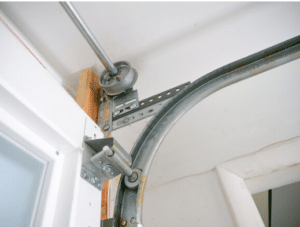
One of the leading causes of an off-track garage door is an obstruction in the track. Even small objects, such as dirt or debris, can block the path of the rollers, causing the door to slip off its track or stop functioning altogether.
Symptoms:
- Grinding or screeching sounds when the door is in motion.
- Jerky movement or halts in the door’s operation.
- Visible debris or objects obstructing the tracks.
Detailed Solution:
If you notice any blockages, your first step should be to clean out the tracks. Use a damp cloth to wipe the inside of the tracks, removing dirt, grease, and debris that may have accumulated. If larger items, such as small rocks or broken parts, are found, remove them carefully. Consider using a track cleaner or a degreaser for stubborn dirt or rust.
Cleaning and inspecting the tracks regularly for blockages can prevent future issues. Implementing a monthly maintenance routine that includes clearing the tracks of debris will help keep the door functioning smoothly.
2. Worn Out Rollers
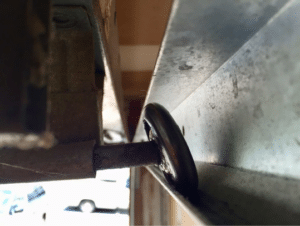
Over time, garage door rollers can wear down, becoming less effective or breaking altogether. Damaged rollers prevent the door from gliding smoothly along the track, eventually causing it to derail.
Symptoms:
- The noisy operation is often described as grinding, squeaking, or rattling.
- Uneven movement of the door as it opens or closes.
- Rollers appear cracked, misshapen, or misaligned in the track.
Detailed Solution:
Replacing worn-out rollers is straightforward, though caution is required due to the door’s weight. If the rollers are damaged, they should be replaced immediately to prevent further misalignment. Garage door rollers come in different materials, such as nylon and steel. Nylon rollers tend to be quieter, while steel rollers are more durable. Opt for high-quality, heavy-duty rollers to avoid frequent replacements.
During roller replacement, ensure the door is securely supported and disengage the opener to prevent accidental movement. After installation, lubricate the rollers with a silicone-based spray to ensure smooth operation.
3. Loose or Damaged Overhead Door Track
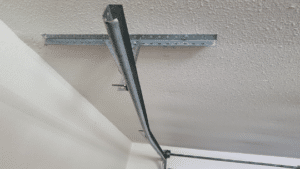
The track that guides the door can become loose over time, causing the door to wobble or come off-track. This can happen due to general wear, environmental factors, or accidental impacts.
Symptoms:
- Uneven gaps between the door and the frame.
- Metal squeaking sounds while the door is in motion.
- Visible bends or damage in the track.
Solution:
First, inspect the track to identify any loose bolts or visible damage. If you find any, tighten all the bolts and screws that hold the track in place. If the track itself is bent, you may need to bend it back into place using a rubber mallet carefully. In cases of severe damage, replacement of the track might be necessary.
It’s also a good idea to check for corrosion, especially if your garage door operates in a humid environment. Rust can weaken the track and cause long-term problems, so using a rust inhibitor or replacing sections of a corroded track can prevent future misalignment.
4. Improper Track Alignment

Improper alignment of the garage door track is a frequent cause of operational problems. When the tracks are not aligned correctly, the rollers can’t move freely, which results in the door coming off-track.
Symptoms:
- The door is hard to open or close.
- It gets stuck at certain points in its movement.
- The tracks appear misaligned or bent.
Solution:
It is crucial to check the alignment of your garage door’s tracks. Using a level, you can check whether the tracks are even. If misaligned, loosen the bolts holding the track to the frame, realign the track, and retighten the bolts. Make sure the track is perfectly vertical for the vertical portion and slanted for the horizontal portion.
While it may seem like a quick fix, professional help is often recommended to ensure alignment precision and avoid further complications.
5. Faulty Operation of Garage Door
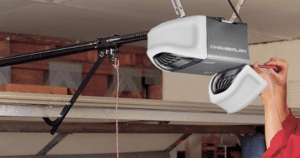
Issues with the garage door opener can cause the door to behave erratically, putting excess strain on the tracks and causing the door to come off. The motor, sensors, and control settings must function harmoniously to keep the door moving smoothly.
Symptoms:
- Inconsistent movement, such as the door stopping midway or reversing unexpectedly.
- Unusual sounds coming from the motor.
- Sensors not responding or signaling an error.
Solution:
Check the garage door opener’s settings, ensuring it’s correctly programmed. Sometimes, a simple reset or recalibration of the sensors can resolve the issue. However, if the motor or gears within the opener are malfunctioning, a technician might need to replace or repair them.
Ensure that safety sensors are aligned correctly as well. These small devices are located near the floor on either side of the garage door and prevent the door from closing if something is in the way. Misaligned sensors can disrupt the door’s operation and cause the opener to behave erratically.
6. Age and Wear
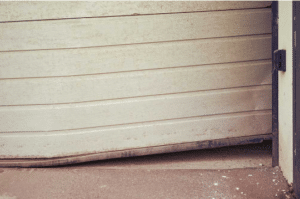
As your garage door system ages, its components naturally wear down. Springs lose tension, cables fray, and the door itself can weaken, all of which increase the likelihood of the door coming off-track.
Symptoms:
- Visible rust, corrosion, or general wear on the door’s components.
- The door becomes heavier, harder to lift, or makes grinding noises during operation.
- Increasing frequency of malfunctions or breakdowns.
Solution:
Preventive maintenance is key. Schedule yearly inspections with a garage door professional who can identify and replace worn parts before they cause significant problems. Lubricating springs, hinges, and rollers regularly will prolong their life and ensure the door’s smooth operation.
7. Broken or Weak Springs
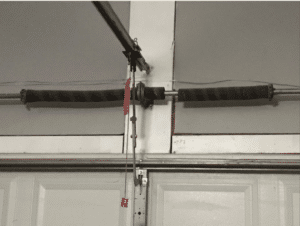
Garage doors rely on powerful tension springs to help lift their weight. When these springs break or weaken, the door becomes unbalanced and may shift off the tracks.
Symptoms:
- The door feels heavier than usual or challenging to lift.
- You hear a loud snapping noise, indicating a broken spring.
- The door only opens partially or slams shut unexpectedly.
Solution:
A broken spring is a serious issue that requires immediate attention. Garage door springs are under immense tension, so replacing them should only be done by a professional. Attempting to replace a garage door spring without the right tools and experience can result in injury.
8. Cable Problems
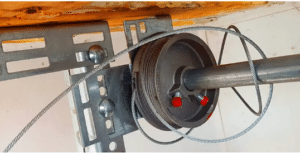
Garage door cables help control the door’s movement, supporting its weight along the tracks. If a cable snaps or becomes loose, the door may shift and come off-track.
Symptoms:
- The door hangs unevenly, with one side lower than the other.
- Visible signs of frayed or broken cables.
- Difficulty opening or closing the door.
Solution:
If a cable has broken or frayed, contact a professional to replace it immediately. While cable replacement might seem straightforward, garage doors are heavy, and cables are under tension, making it a dangerous task for those without experience.
Additionally, inspect cables regularly for wear and tear to avoid unexpected failures.
9. Lack of Maintenance

A lack of routine maintenance can cause garage door components to wear down prematurely. Dust, debris, and rust can build up over time, leading to malfunctions.
Symptoms:
- Increased friction and resistance during operation.
- Squeaking or grinding noises due to lack of lubrication.
- Parts appear rusted or corroded.
Solution:
Regularly laminate moving parts, such as rollers, springs, and tracks, to keep your garage door running smoothly. A basic maintenance routine every few months should include cleaning the tracks, inspecting the springs and cables, and testing the door’s balance.
Professional servicing at least once a year is recommended to catch potential issues before they lead to an off-track door.
10. Impact Damage – Backed Car Into Garage Door

Accidental impacts are another common cause of an off-track garage door. Backing into the door with a vehicle or hitting it with a heavy object can bend the tracks or damage other components.
Symptoms:
- Dents or visible bends in the tracks.
- The door doesn’t close evenly or looks misaligned.
- Cracked or damaged panels on the door.
Solution:
If the door has been impacted, check for visible damage and consult a professional for repairs. In some cases, the tracks can be bent back into shape, but if the impact is severe, you may need to replace sections of the door or the entire track system.
11. Improper Overhead Door Installation
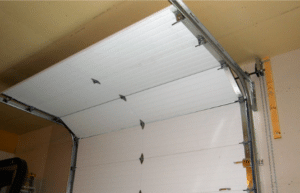
Incorrect garage door installation can lead to operational issues and cause the door to come off its tracks prematurely. Even if all parts are new and in good condition, poor alignment or loose components can lead to trouble.
Symptoms:
- Frequent operational issues, especially shortly after installation.
- Gaps or unevenness between the door and frame.
- Noisy operation right from the start.
Solution:
A professional must correct improper installation. If you suspect your new garage door was not installed correctly, contact an experienced technician to evaluate and realign the components. Improper installation can significantly reduce the lifespan of your garage door and lead to recurring issues.
Frequently Asked Questions (FAQs)
Why does my garage door stop closing?
A garage door can stop closing due to blocked sensors, misaligned tracks, or obstructing the door’s path. Other causes include damaged springs, worn-out rollers, or problems with the opener’s safety feature. Inspect the door’s components or consult a professional if the issue persists.
How do I know if my garage door sensor is bad?
If your garage door won’t close or reverses after starting to close, the sensors might be bad. Check if the sensor lights are blinking or misaligned. Dirty or obstructed sensors can also cause problems. If cleaning and realigning don’t work, it’s likely time to replace the sensors.
Why does my garage door close and then reopen?
A garage door that closes and reopens is usually triggered by safety sensors detecting an obstruction. Check the sensor alignment and clear any objects blocking the path. Alternatively, the close-limit setting on the opener might need adjusting to prevent the door from thinking it’s hitting something.
Why won’t my garage door stay up?
If your garage door won’t stay up, the torsion springs might be broken or out of balance. Springs counterbalance the door’s weight; the door may fall if it fails. Worn cables or a faulty opener can also cause this issue. It’s best to have a professional inspect it.
Why is my garage door not opening and closing smoothly?
A garage door that doesn’t open or close smoothly may have dirty or damaged rollers, misaligned tracks, or worn-out springs. Check for debris along the track and lubricate the rollers. If these steps don’t help, a professional may need to realign the door or replace worn parts.
Conclusion
A garage door coming off-track is often preventable with proper care, regular maintenance, and prompt attention to issues as they arise. Whether the cause is worn rollers, misaligned tracks, or accidental damage, addressing the problem quickly will help you avoid bigger, costlier repairs.
Routine inspections and maintenance can ensure that your garage door remains in good working order for years. Prioritize safety and don’t hesitate to call a professional when necessary—garage door systems are complex and dangerous to garage door repair without the proper knowledge and tools.
End Note
At Tarrant County Door & Gate, we understand how frustrating a garage door off-track can be. Whether it’s worn rollers, debris in the tracks, or a misaligned door, we’ve seen it all and fixed it all. Our team is here to help with all your garage door needs, from repairing broken springs to installing new keypads or remote controls. We proudly serve Tarrant County, including Keller, Southlake, Colleyville, and more.
Need emergency service? We’ve got you covered with 24/7 emergency garage door repair. For more about our services, visit our homepage and check out our gallery to see some of our work. Learn more about us here or contact us directly here. We’re just a call away from getting your door back on track!
For more insights, read our blog or learn about our drive gate services here.

